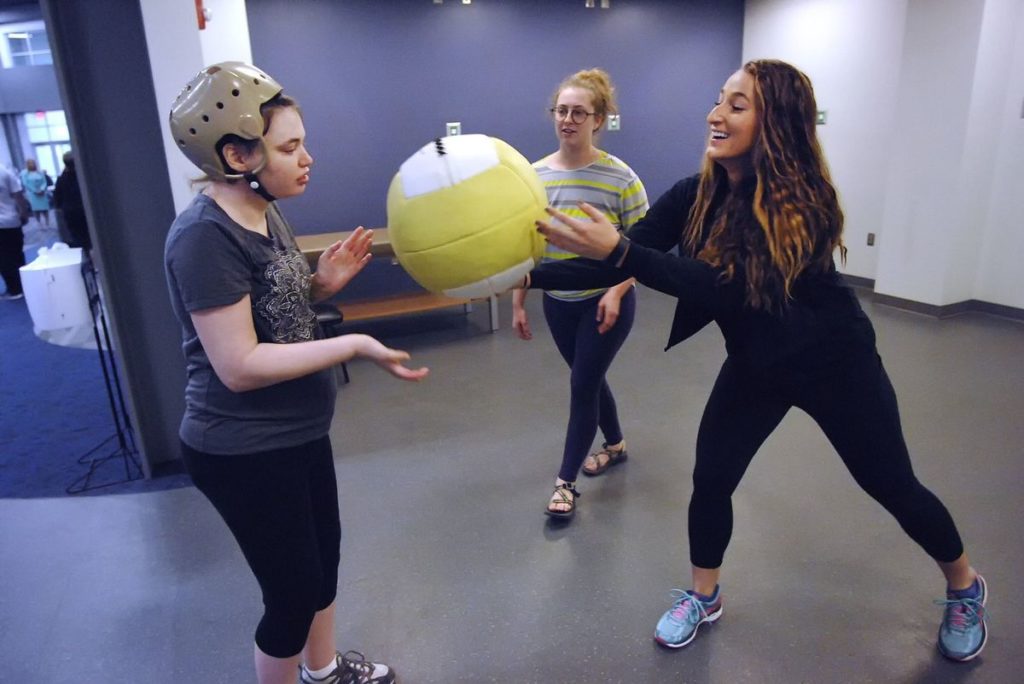Fitness Program Reaches People with Disabilities
BLOOMINGTON — Exercise programs for people with disabilities are nothing new.
But a new, medically supervised pilot program targets a group of people with developmental and intellectual disabilities. After one year, program partners — the McLean County Health Department, Advocate BroMenn Health & Fitness Center and Marcfirst — will analyze each participant’s health and fitness data to determine whether to continue the program and perhaps expand it.
“Our overall goal is for individuals with disabilities to have the same opportunities as people without disabilities,” said Laura Beavers, health department behavioral health division manager.
“It’s almost two months into the program and, so far, it has exceeded expectations based on program participation and member feedback,” said Molly Smeltzer, the health and fitness center’s fitness and wellness manager.
On May 23, Nicole Ward was among several people working out at the center. She picked up a medicine ball, steadied herself and threw it to the floor.
“Slam it down!” she yelled at the encouragement of her personal trainer/health coach Sara Freed and caregiver Karly Enger.
She did that 10 times, the most she’d ever done. Next, she played catch using an inflatable ball.
“Nice throw,” Freed said after Ward tossed the ball to her. “This is her first time throwing it. And she’s doing a lot better catching it instead of letting it slide off her,” Freed said.
A few feet away, Neysa Danilson did rail-assisted squats for the first time — holding onto a bar in front of her, squatting onto her wheelchair, then back up again.
“Push through your heels. There you go. Remember to use your legs more than your arms,” said her coach, Cody Haenitsch.
Jeffrey Sapp-Paris worked out on battle ropes, coached by Smeltzer. “Getting better,” Sapp-Paris said.
The health department and the McLean County Board for Care and Treatment of Persons with a Developmental Disability had been exploring wellness opportunities for people with developmental disabilities because research shows they are three times more likely to have heart disease, stroke, diabetes and cancer than people without disabilities, Beavers said.
Furthermore, people with a developmental disability die, on average, 25 years earlier than people without disabilities, Beavers said.
The health department first approached Advocate BroMenn Health & Fitness Center — which develops individualized, medically monitored fitness programs — and then Marcfirst, which has programs for people with disabilities.
“We’ve always had a wellness component, encouraging people to walk and eat healthier” but the new program takes that to a new level, said Marcfirst CEO Laura Furlong.
The program began April 1. There is no charge to the individuals because, for the first year, the disability board is spending $40,338.80 from a tax levy designed for individuals with disabilities.
In addition, “Advocate Charitable Foundation has created a fund for incidental expenses and to expand the program and carry it beyond this year,” Beavers said.
Funding is available for 41 Marcfirst clients and their caregivers. So far, 22 people with disabilities and 18 of their support people are participating, Smeltzer said.
Their health histories have been taken, they have received doctor’s approval to begin exercise, they have undergone health screenings, discussed their fitness goals, and exercise plans have been developed to help them to reach those goals, Smeltzer said.
While each exercise prescription is different, generally each program calls for 20 to 30 minutes of cardiovascular exercise, strength training and core and flexibility exercises two to three times a week, Smeltzer said.
Each participant has their own “Technogym Key” which plugs into each exercise machine to remind members of their exercise weight, repetitions, numbers of sets — or amount of time — and what exercise to do next. The key also records exercise, giving coaches another opportunity to monitor members’ progress, Smeltzer said.
Ward, 33, who lives in a Marcfirst group home in Normal, has an intellectual disability, a seizure disorder and wears a helmet because she has a poor gait and is a fall risk. Her exercise prescription includes working with resistance bands, the medicine ball, the inflatable ball, stepping up onto a box and walking on the track.
Danilson, 45, who lives in an apartment in Bloomington with Marcfirst support, has cerebral palsy and uses a wheelchair. “My goal is to walk with crutches,” she said.
She uses an exercise bike and arm bike, does a variety of upper and lower body strength training and has added rail-assisted squats. “It makes me stronger in my legs and arms,” Danilson said. “It makes me feel good.”
Sapp-Paris, 24, who lives in a Marcfirst home in Bloomington, has autism and wants to lose weight. In addition the battle ropes and exercise bike, he does a variety of upper and lower body weight machines.
“He’s getting very comfortable with his workout and, after gym days, he’s more conscious of what he’s eating,” said his support person, Kim Fischer.
So far, the program has been a success, organizers agree.
“Everyone is excited to go,” Furlong said. “Having a place to go where people know your name, where you are a part of the community — that is a very rich part of this.”
Freed turned to Ward and said “This is your gym.”
“Yeah!” Ward responded.

